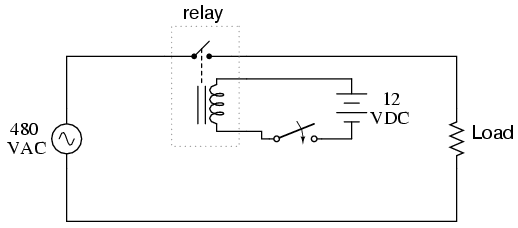How do Relays and Triacs Work?
Whether a control board in an appliance is simple or sophisticated, there's one trick it has to pull off: switching high AC voltage using low control voltage. They pull this off by using relays or triacs, devices that all of us are at least passingly familiar with.
But how do these very common control components work, exactly? And how is troubleshooting a relay different from troubleshooting a triac? That's what we'll look at today.
Relays: The older and simpler of these two devices, relays -- more precisely called "electromechanical relays" -- are very simple devices. They use the property of electromagnetism to allow a low DC voltage to physically change the position of a switch, thereby either opening or closing a high-voltage AC circuit.
Did you ever make an electromagnet in school by wrapping a wire around a piece of metal and connecting the wire to a battery? Well that kind of electromagnet is almost exactly the same kind used in relays. When the control board applies a low DC voltage (often 12 VDC) to the coil, it creates a magnetic field which pulls on a metal arm, actuating the switch.
Relays can be designed as either Normally Closed or Normally Open. A Normally Closed relay opens when the electromagnet is activated, and vice versa for Normally Open relays.
The schematic below should let you visualize this pretty well:

You've got two different parts of the relay that are liable to fail: the coil, and the high-voltage switch that the coil actuates. The switch contacts, for example, can arc and fuse together, permanently closing the relay. Alternatively, the electromagnet coil could go open, meaning that the relay would no longer be able to actuate.
Triacs: Triacs perform exactly the same function as relays, but without any moving parts. They're electronic components, and therefore completely non-mechanical. We won't get too deep into how they're constructed, but if you want to take a deeper dive, check out this post.
Basically, triacs are made of a specially engineered material called a P-N junction. This P-N junction normally prevents the flow of current, but when two specific conditions are met, itcan allow current to flow, just like a closed switch. These two conditions are:
1. There must be a small DC voltage applied to the triac, which is called the gate voltage. This is how the computer board controls when the triac closes. It performs the same function as the DC voltage that powers the electromagnet in a relay.
2. There must be a valid AC power supply connected to either side of the P-N junction. This is because, even with that gate voltage present, there must also be a high AC voltage present that can break down the P-N junction and close the triac.
The diagram below shows the schematic symbol for a triac. A1 and A2 are where the AC power supply would be connected, and the line marked G is for the gate voltage.

Triacs and relays use very different technology to perform the same simple task, but they accomplish it differently. It's important to be aware of these differences, since they factor into troubleshooting.
The most important distinction is that triacs need a valid power supply -- both line and neutral -- in order to close. This makes troubleshooting triacs different from relays, because you can't check a triac when it's disconnected from its circuit like you can with a relay. This can cause difficulties in identifying whether the issue in a circuit is the triac or the load. But fortunately, there's a trick to get around this! You can simply bypass the triac with a jumper wire. If the load in the circuit begins running, then you know the culprit is the triac.
Want to learn more about the how the technology in appliances works and how that knowledge factors into troubleshooting? Click here to check out our courses over at the Master Samurai Tech Academy.
-
.png) 4
4

.png.62a7d7300de75dfbd19764a318766630.png)


0 Comments
Recommended Comments
There are no comments to display.